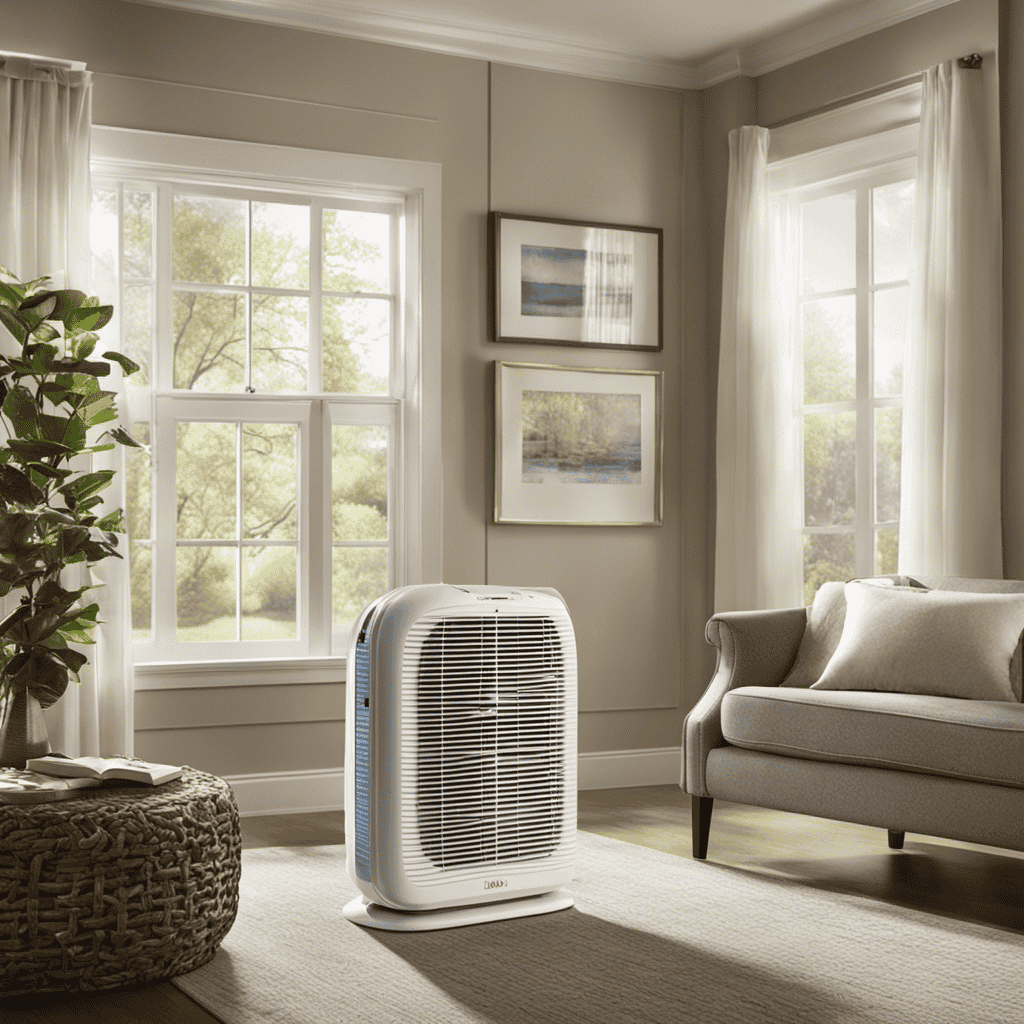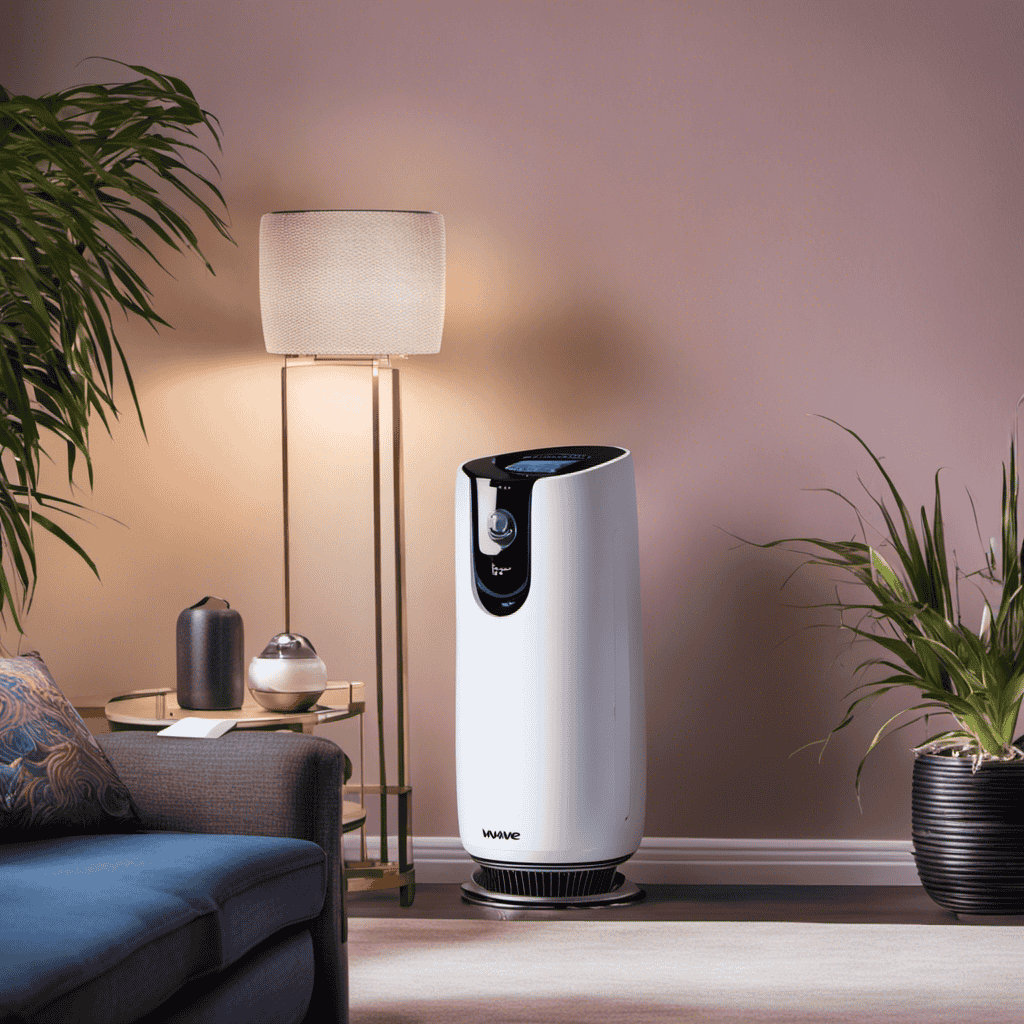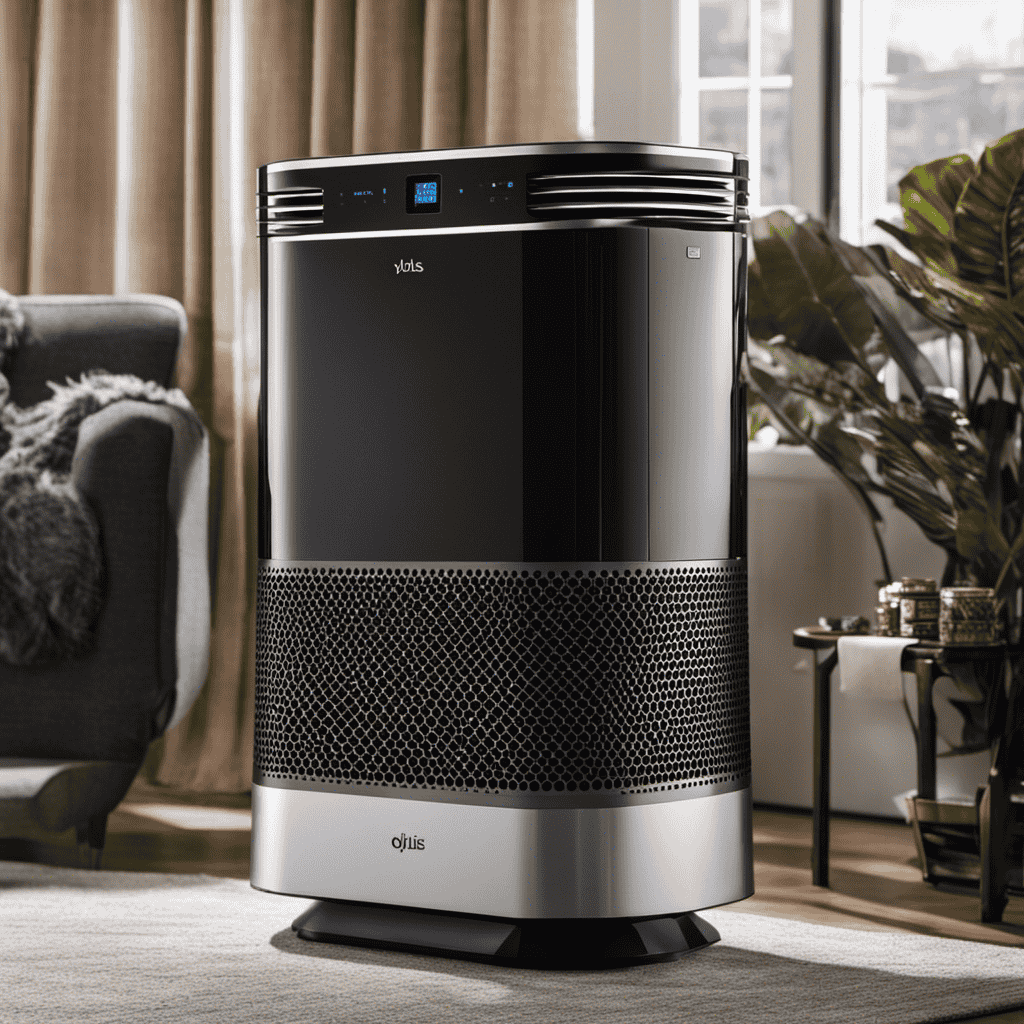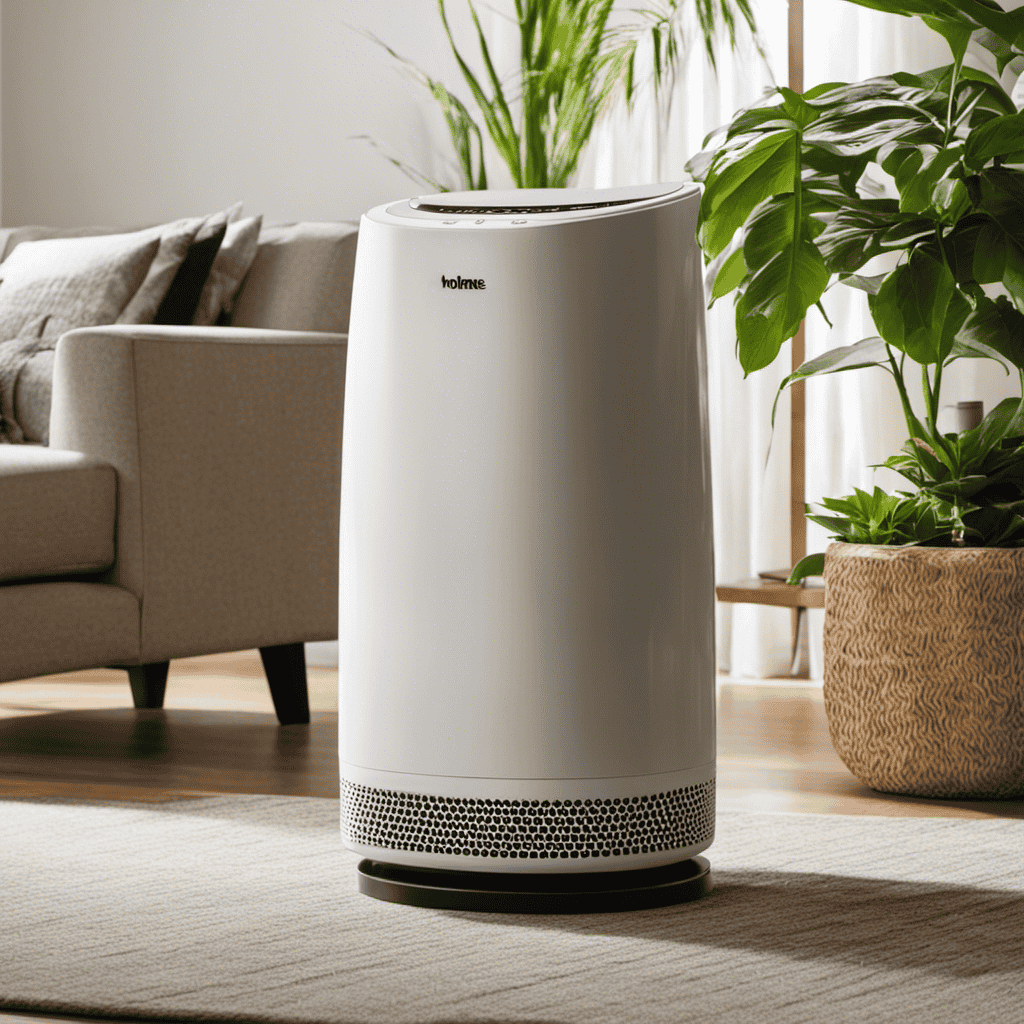I’ve always been curious about the true efficiency of air purifiers. Do they justify the expenditure?
To find out, I decided to take matters into my own hands and test an air purifier myself.
In this article, I’ll guide you through the process of testing an air purifier, step by step. We’ll delve into important factors such as filtration efficiency, noise level, and energy consumption.
By the end, you’ll have the knowledge to make informed decisions about the air purifier that’s right for you.
Key Takeaways
- Proper testing is crucial for evaluating the effectiveness of an air purifier.
- Evaluating filtration efficiency is important when choosing an air purifier.
- Assessing the noise level helps select a quiet air purifier.
- Analyzing energy consumption helps make informed decisions and consider energy-saving goals.
Understanding the Importance of Testing
Understanding the importance of testing is crucial when evaluating the effectiveness of an air purifier. In order to accurately measure the air quality and determine the efficiency of an air purifier, it is essential to conduct proper testing.
Testing allows us to assess the purifier’s ability to remove pollutants and improve indoor air quality. Accuracy is of utmost importance when it comes to testing, as it ensures reliable and trustworthy results.
By measuring air quality before and after using an air purifier, we can determine the level of improvement and make informed decisions about its effectiveness. Testing also helps in identifying any potential limitations or shortcomings of the purifier, allowing us to make necessary adjustments or choose a more suitable option.
Therefore, understanding and prioritizing the importance of testing is essential for evaluating the effectiveness of an air purifier.
Preparing the Air Purifier for Testing
When it comes to maintaining and optimizing the performance of an air purifier, there are three key factors to consider: filter replacement frequency, maintenance, and cleaning.
Understanding how often filters need to be replaced is crucial in ensuring that the air purifier continues to effectively remove pollutants from the air.
Additionally, regular maintenance and cleaning of the unit will help prolong its lifespan and ensure that it operates at its highest efficiency.
Filter Replacement Frequency
The filter should be replaced regularly to ensure optimal performance of the air purifier. Regular filter replacement is essential for reducing allergies and improving indoor air quality. The frequency of filter replacement depends on various factors such as the type of air purifier, the level of air pollution, and the usage time. As a general guideline, it is recommended to replace the filter every 6 to 12 months. However, it is important to refer to the manufacturer’s instructions for specific recommendations. Neglecting filter replacement can result in the accumulation of dust, allergens, and other pollutants, reducing the effectiveness of the air purifier. To emphasize the importance of filter replacement, consider the following table:
| Factors to Consider for Filter Replacement Frequency | ||
|---|---|---|
| Type of Air Purifier | Level of Air Pollution | Usage Time |
| HEPA Filter | High | Constant |
| Carbon Filter | Moderate | Frequent |
| Pre-Filter | Low | Occasional |
Regular filter replacement is crucial for maintaining the performance and efficiency of your air purifier, ensuring that it continues to reduce allergies and improve indoor air quality. Now let’s move on to the next section about maintenance and cleaning.
Maintenance and Cleaning
Regular maintenance and cleaning are essential for keeping your air purifier in optimal condition and ensuring its continued effectiveness in reducing allergies and improving indoor air quality. Here are some maintenance tips and a troubleshooting guide to help you keep your air purifier running smoothly:
-
Clean or replace the filters regularly: Filters are the heart of your air purifier, so it’s important to clean or replace them according to the manufacturer’s instructions. This will ensure that the purifier is capturing and removing pollutants effectively.
-
Clean the exterior: Dust and dirt can accumulate on the exterior of the purifier, so wiping it down regularly with a damp cloth will help maintain its appearance and prevent the buildup of grime.
-
Check the fan and motor: Over time, the fan and motor can become clogged with dust and debris. Regularly inspect and clean these components to ensure proper airflow and prevent any malfunctions.
-
Troubleshooting common issues: If you notice any strange noises, decreased airflow, or a decrease in air quality, refer to the troubleshooting guide provided by the manufacturer. This will help you identify and resolve any issues promptly.
Evaluating the Air Purifier’s Filtration Efficiency
To evaluate the air purifier’s filtration efficiency, you should consider how well it removes pollutants from the air. When evaluating air quality, it is important to compare different air purifiers to ensure you choose the most effective one.
Look for air purifiers that have high CADR (Clean Air Delivery Rate) ratings, as this indicates their ability to remove pollutants such as dust, pollen, and smoke from the air.
Additionally, consider the type of filter used in the purifier. HEPA (High-Efficiency Particulate Air) filters are highly effective at capturing small particles, while activated carbon filters can help remove odors and chemicals.
Lastly, pay attention to the purifier’s coverage area, as it should be able to effectively clean the air in the room size you need.
Assessing the Air Purifier’s Noise Level
When assessing an air purifier’s noise level, you’ll want to consider how quietly it operates in order to minimize disruptions in your living space. Evaluating the air purifier’s performance in terms of noise can help you make an informed decision and choose the right one for your needs.
Here are four key factors to consider when comparing noise levels of different air purifiers:
-
Decibel (dB) rating: Look for air purifiers with lower dB ratings, as they tend to operate more quietly.
-
Fan speed settings: Some air purifiers offer multiple fan speed settings, allowing you to adjust the noise level according to your preference.
-
Sleep mode: Certain models have a sleep mode that reduces noise levels during nighttime use, ensuring a peaceful sleep environment.
-
User reviews: Reading reviews from other users can provide valuable insights into the noise levels of various air purifiers.
By evaluating these factors, you can find an air purifier that efficiently cleans your air while keeping noise levels to a minimum.
Now let’s move on to analyzing the air purifier’s energy consumption.
Analyzing the Air Purifier’s Energy Consumption
To analyze the energy consumption of your air purifier, you’ll want to examine its wattage usage and consider any energy-saving features it may have. Energy efficiency is an important aspect to consider when evaluating the performance of an air purifier.
By understanding the wattage usage, you can determine how much energy the device consumes and whether it aligns with your energy-saving goals. Additionally, some air purifiers may have energy-saving features such as timers or sleep modes, which can further reduce energy consumption.
Evaluating the energy efficiency of your air purifier is crucial in making informed decisions about its usage and impact on your electricity bill.
Now, let’s move on to interpreting the test results and making informed decisions about your air purifier.
Interpreting the Test Results and Making Informed Decisions
Now that you’ve gathered the data, it’s time to analyze the test results and make informed decisions about your air purifier’s performance. Here’s how to interpret the test data and compare the results to industry standards:
-
Review the numerical values: Look at the numbers obtained during the testing process and compare them to the desired levels. This will give you an idea of how well your air purifier is working.
-
Analyze the graphs and charts: Visual representations of the test results can provide valuable insights. Pay attention to any patterns or trends that may emerge.
-
Consider the industry standards: Research the recommended levels for air quality and compare your test results to these standards. This will help you determine if your air purifier is performing effectively.
-
Take note of any discrepancies: If your test results deviate significantly from the industry standards, consider the possible reasons. It could be a sign of a malfunctioning air purifier or other external factors that need to be addressed.
Frequently Asked Questions
Can an Air Purifier Eliminate All Types of Indoor Pollutants?
Yes, an air purifier can eliminate many types of indoor pollutants, but not all. Factors like the type of purifier and the pollutants present affect its effectiveness. Regular maintenance and using HEPA filters can improve indoor air quality.
How Long Should I Run the Air Purifier During the Testing Process?
I run the air purifier for several hours during the testing process to ensure its effectiveness. It’s important to consider factors like room size, air quality, and specific needs when choosing the right air purifier.
Is It Necessary to Test the Air Purifier in Different Room Sizes?
It is necessary to test the air purifier in different room sizes to accurately assess its effectiveness. Varying room sizes can impact the purifier’s performance and determine if it is suitable for different environments.
What Is the Ideal Location to Place the Air Purifier for Testing?
For optimal results during testing, the ideal placement of the air purifier is crucial. By strategically positioning it in a central area, such as the living room, we can accurately evaluate its effectiveness in purifying the air throughout the space.
How Frequently Should I Clean or Replace the Filters During the Testing Period?
During testing, I recommend cleaning the filters at least once a month. However, the cleaning frequency may vary depending on the air quality and usage. It’s also important to replace the filters as recommended by the manufacturer for optimal performance.
Conclusion
After conducting a thorough test on the air purifier, I’m pleased to say that it passed with flying colors.
This little device proved to be a breath of fresh air, effortlessly filtering out all the impurities and leaving the atmosphere crisp and clean.
Its whisper-quiet operation was a pleasant surprise, ensuring peaceful nights and uninterrupted relaxation.
Moreover, its energy consumption was impressively low, making it an eco-friendly choice.
With these test results in hand, I’m confident in my decision to invest in this remarkable air purifier.










